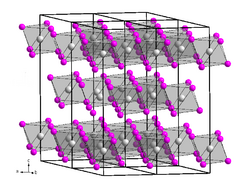Chemistry:Chromium(III) bromide

| |
| Names | |
|---|---|
| IUPAC name
Chromium(III) bromide
| |
Other names
| |
| Identifiers | |
| |
3D model (JSmol)
|
|
| ChemSpider | |
| EC Number |
|
PubChem CID
|
|
| UNII | |
| |
| |
| Properties | |
| CrBr 3 | |
| Molar mass | 291.708 g·mol−1 |
| Appearance | Black lustrous crystals; green in transmitted light, reddish in reflected light[1] |
| Density | 4.25 g/cm3[2] |
| Melting point | 1,130 °C (2,070 °F; 1,400 K) (anhydrous)[2] 79 °C (hexahydrate) |
| anhydrous: insoluble in cold water, soluble with addition of Chromium(II) ion salts,[1] soluble in hot water;[2] hexahydrate: highly soluble[2] | |
| Structure | |
| trigonal | |
| Hazards | |
| NIOSH (US health exposure limits): | |
PEL (Permissible)
|
TWA 1 mg/m3[3] |
REL (Recommended)
|
TWA 0.5 mg/m3[3] |
IDLH (Immediate danger)
|
250 mg/m3[3] |
Except where otherwise noted, data are given for materials in their standard state (at 25 °C [77 °F], 100 kPa). | |
| Infobox references | |
Chromium(III) bromide is an inorganic compound with the chemical formula CrBr
3. It is a dark colored solid that appears green in transmitted light but red with reflected light. It is used as a precursor to catalysts for the oligomerization of ethylene.
Synthesis
The compound is prepared in a tube furnace by the reaction of bromine vapor and chromium powder at 1000 °C. It is purified by extracting with absolute diethyl ether to remove any CrBr
2, and is subsequently washed with absolute diethyl ether and absolute ethanol.[1]
Analogous to the behavior of related chromium(III) halides, the tribromide dissolves in water to give CrBr
3(H
2O)
3 only upon the addition of catalytic amounts of a reducing agent, which generates CrBr
2.[1] The reducing agent generates chromous bromide on the surface of the solid, which dissolves and re-oxidizes to Cr(III).[citation needed]
Reactions
Chromium(III) bromide is reduced by hydrogen gas at 350-400 °C to give chromium(II) bromide:[1]
- 2 CrBr
3 + H
2 → 2 CrBr
2 + 2 HBr
References
- ↑ 1.0 1.1 1.2 1.3 1.4 Brauer, Georg (1965) (in de). Handbuch Der Präparativen Anorganischen Chemie. 2. Stuttgart; New York, New York: Ferdinand Enke Verlag; Academic Press, Inc.. p. 1340. ISBN 978-0-32316129-9. https://books.google.com/books?id=Pef47TK5NfkC. Retrieved 2014-01-10.
- ↑ 2.0 2.1 2.2 2.3 Perry, Dale L. (2011). Handbook of Inorganic Compounds, Second Edition. Boca Raton, Florida: CRC Press. p. 122. ISBN 978-1-43981462-8. https://books.google.com/books?id=SFD30BvPBhoC. Retrieved 2014-01-10.
- ↑ 3.0 3.1 3.2 NIOSH Pocket Guide to Chemical Hazards. "#0141". National Institute for Occupational Safety and Health (NIOSH). https://www.cdc.gov/niosh/npg/npgd0141.html.
 |

